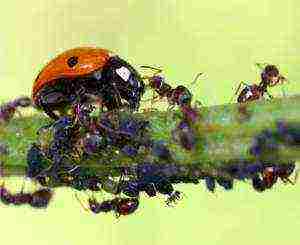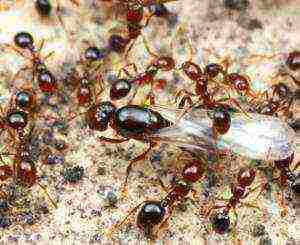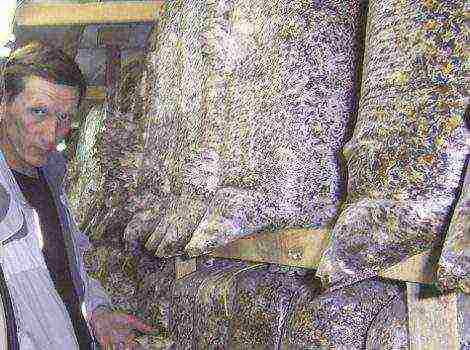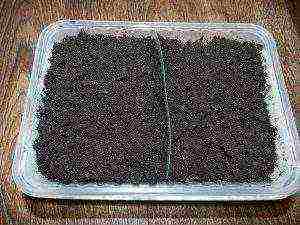 Before starting the question keeping ants at home, it is important to learn better about the features of such insects.
Before starting the question keeping ants at home, it is important to learn better about the features of such insects.
They live in their own "caste" society, therefore they are of interest not as separate individuals, but as representatives of the social structure.
Ants belong to the order Hymenoptera, their closest relatives are bees.
All ants are exclusively social insects, live in colonies and act as a large single organism.
Thanks to this, their evolutionary development has gone far ahead (in comparison with other insects), which allowed them to spread widely across our planet and have a dominant position among their fellow insects.
Ant colonies developed through the formation of various highly specialized individuals within one species. For example, soldier ants are larger and have a proportionally large head with powerful jaws.
In some species of ants, the soldiers have such large jaws that they cannot feed on their own! Working ants are smaller individuals without obvious morphological changes, but with different specializations.
Some hunt and search for food, others equip an anthill, nurse (feed and raise larvae) future ants. There are also ants-cooks or barrels-individuals with a large abdomen, they play the role of storage tanks for food.
 The queen is the main ant in their entire society.... This is the largest individual of the species, the main function is laying eggs, reproduction of ants.
The queen is the main ant in their entire society.... This is the largest individual of the species, the main function is laying eggs, reproduction of ants.
It is the queen ant that monitors the ratio of individuals.
How many soldiers and workers there will be, it is up to her to decide. When males appear for mating and more queens that scatter and form new colonies, it depends on her decision.
Many ants are engaged in their own livestock raising: they grow aphids, protect herds from predatory insects, and drive them to the more juicy parts of plants.
Ants also have their own greenhouses, some species cultivate a fungus, which they choose the most suitable conditions in the anthill and, if necessary, are transferred to new places.
Most ant species live in colonies on a permanent territory, creating large dwellings on and underground, there are also stray species. Ants are omnivorous, consume animal and plant foods, and often play an important sanitary role in the natural ecosystem.
Many types of ants can be kept at home.. If the goal is to recreate a full-fledged durable colony, then it is better to use tropical species.
Small flat helium nests are often on sale and are great for keeping a small group of any kind of ants. You can eat the gel in such anthills, the ants will eat up the winding passages in it until they swallow it all.
 If you set yourself a more serious goal (to simulate a viable colony), then first of all you need to acquire a queen ant, it will give rise to the future goosebumps.
If you set yourself a more serious goal (to simulate a viable colony), then first of all you need to acquire a queen ant, it will give rise to the future goosebumps.
Nowadays, interesting ready-made versions of anthills (formicaria) made of glass, gypsum and plastic are often offered for sale.
You can create an anthill yourself.
Before you start contain ants, you should acquire in advance forage insects or find out the possibilities of their uninterrupted acquisition, since they are the main diet of ants.
Crickets and cockroaches, which do not have to be alive, are fine, but frozen ones are fine.You can also feed the ants with fresh fruit and boiled vegetables. Food for ants should be put in small portions as they are consumed.
In no case should the food stale, this will lead to the appearance of mold (and other unwanted organisms) and the extinction of the anthill.
It is sometimes necessary to spray ants a little, it is advisable to have a drinker with a small level (no more than 1 mm) of water so that it does not dry out. You can use foam rubber or cotton wool put in the drinker.
If you take responsibility for keeping ants, then, undoubtedly, a home anthill (carefully thought out formicarium) will not only be an excellent visual aid for novice entomologists, but also a decoration of any room.
Who in childhood did not observe insects, especially ants? But keeping them at home - not every animal lover will go for it. Many are frightened by their number and lack of knowledge of living conditions. For example, in one nest, and this is one large "family", of an ordinary black garden ant, there can be up to 10,000 individuals. But lately it has become quite exciting to observe their daily life. Many of the biology course probably remember that ants feed on dead arthropods, plant seeds, nectar, and also breed and graze aphids and spend whole days arranging their homes. That's basically it. But those who decided to breed these insects soon discover a truly amazing "world", a whole state with its own hierarchy, laws and regulations. And the building of the kingdom begins with one female. And to start breeding ants at home, it is also better with this very "future queen".
Consider breeding our pets using the example of a black garden ant.
They live in our latitudes. Everyone has seen these little black insects. Their dimensions barely exceed 3-4 mm. They dig their burrows in the ground. At the same time, preferring open areas. Above the entrance rises a small mound of glued pieces of "waste" earth. They feed on dead invertebrates, plant nectar and aphid honeydew. All ants are sterile females that are the offspring of one uterus. Among them there are two castes - workers and soldiers. On average, an ant lives for 2-3 years. Uterus - up to 25 years old! Record among ants.
This ant species is well suited for keeping at home. Especially for a beginner. Does not require the creation of special climatic conditions. First you need a test tube, water, cotton wool and formicarium (this is the place for your future "family"), but more about it below. Now you need to catch the fertilized female. In black garden ants, breeding occurs in May, first half of June. You can distinguish a fertilized female by its larger size and slightly flattened middle segment of the body, on which there will be traces of bitten off wings. And you can find it, sometimes in the most unusual places. This female must be placed in the same test tube. But first it is necessary to pour up to 1/4 of water into it and plug this "water compartment" with cotton wool. Now everything - the queen is now better left alone.
Before the first workers appear, food is not needed. And then, when the female lays several eggs, she should be fed with protein-containing food - these can be the corpses of small insects, worms, preferably bloodworms. The first generation of worker ants also need to be fed carbohydrates (honey, syrup). Since the appearance of the second "batch" of working insects, your impromptu lullaby must be relocated to a specially equipped place for keeping ants - formicaria. For beginners, a 60 gallon aquarium is best. It should be 1/2 filled with "soil" (alabaster is best suited for this purpose). From above, the formicaria should be tightly closed, but well ventilated. In it, you yourself make labyrinthine moves so that some of them are visible in section, and it is convenient to observe the family of ants, because for this, the construction of the entire empire is being started.
Next, you need to allocate a place for feeding.Of course, it is better to cut a small hole on one of the walls and connect it to another small aquarium (10 liters is enough). This will be the arena where the feeder should be placed. Remember that "food" must always be fresh and in sufficient quantity - the ants will figure out how much food they need. As for maintaining the temperature regime, special heating is not required for the ants of our strip. What to feed? All generations and castes are in the colony. Therefore, you need a varied diet. A constant combination of protein and carbohydrate components. Honey works well, but remember that it crystallizes and deteriorates quickly, you can use sugar syrup, which should be constantly replaced with fresh one. Larvae of cockroaches, crickets, insects themselves, small invertebrates.
Similar articles:
- Madagascar cockroaches: care and maintenance
- Anama stick insect
- Firefly
- Glass ant city lazius
- Crickets. Breeding for feed
If you are reading this material, then the first step has been taken - Are you interested in ants!
We will try to smoothly bring you up to date and roughly outline everything that you have to do in this regard.
Most likely you will learn about ants a lot of new and amazing. Be surprised how little people actually know about ants and how many different prejudice and misconception about these wonderful laborers.
You can, of course, just catch in a jar a couple of dozen worker ants from a nearby anthill and observe their behavior as they do something together. This is is not a complete maintenance of ants - the ants will die pretty quickly. We we will not consider such options for "content" (but we believe that it can be useful for educational purposes. For example, in order to tell a child about the diversity of nature, about the complex organization, even such small boogers like ants).
Our goal is to tell you about the maintenance of a full-fledged, developing ant colony at home.
Stage I - acquaintance
The first step is to to read a few "bibles" of a novice amateur myrmecologist:
- Crossed Antenna Password
- Secrets of the insect world
- Little toilers of the mountains
- Ant, family, colony
- From bee to gorilla
- Public insects
These wonderful books in a simple and fun way will tell you about ants, how they work, how and where they live. We have arranged these books in order of increasing severity presentation. The first two books are designed for young reader, but, nevertheless, they have very a lot of useful information and for adult amateur myrmecologists.
It is also very helpful to read the section "Frequently asked Questions"... If there was no answer to your question, use the service "Ask a Question" or ask on the forum in the section "Newbie Questions".
Phase II - Reflection
We do not advocate keeping ants in captivity - this is a serious step that requires responsibility and patience... Ants are complex social insects... In fact, they don't care about you. Their purpose in life is prosperity of their family... Therefore, do not expect that they will do as you want, rather everything will be the other way around.
Plus, the most interesting things will happen in your colony. not earlier than in 6-9 months... At first, all you will see is a uterus sitting in a test tube and slowly developing larvae / pupae. Not everyone can stand this, the most difficult and tedious stage - the stage of development of the colony, from one uterus to at least 50 workers.
Think three times! Ants are not the easiest pets. Plus, it's so much exoticthat you will most likely be considered a great original (eccentric :).
Also, you will have to face accompanying insects: flies, cockroaches, crickets, etc. - This not the most pleasant insects in the content. Not everyone can afford to maintain fodder crops - and without these sources of live protein don't get a thriving colony.
But, if you, nevertheless, are ready to go to certain inconveniences - the content of ants will give you, and your family, unforgettable experience from the most interesting observation of the life of ants. How will you rejoice at the firstborn - words cannot convey !!! Your personal civilization on the table!
Stage III - preparation
The plan is simple:
- explore all available pet shops for equipment and feed
- decide where you will take queen ant (buy / catch)
- decide on the desired the kind of ants
- consider where you will keep incubator with uterus (darkness, rest, temperature ~ 27 ° С)
- buy tweezers, a magnifying glass, a couple of test tubes, a thermometer
- try to make an incubator
You can always count on our consultations - ask questions and they will surely answer you.
The colony
functional education consisting of maternal and daughter families maintaining regular family relationships
Myrmecology
the science of ants, part of entomology. Myrmecologists are scientists who study ants.
Insect
a class of invertebrates such as arthropods. The body is divided into a head, chest and abdomen, 3 pairs of legs, most have wings. Breathe with trachea. Development, as a rule, with metamorphosis of an egg, larva, nymph (or pupa), an adult insect. The largest and most diverse group of animals on Earth.
Family
the main form of existence of social insects. Consists of reproductive (females, males) and functionally asexual individuals (workers).
Cockroaches
detachment of insects. Length 4 mm 9.5 cm.Approx. 3600 species, mainly in the tropics and subtropics. In a number of species, the wings are shortened or absent. Some (Prusak, black cockroach, etc.) live in human dwellings. The relic forest cockroach that lives in the south of Primorye is protected.
Social parasitism
the stage of founding families of species, females of which are incapable of independent founding of families, on families of host species.
Slavery
This is one of the forms of social parasitism of ants, in which the family of the parasite lives separately from the family of the owner, but periodically attacks its nests and kidnaps the pupae of the workers. The “slaves” (or “helpers”, in another terminology) emerged from the pupae do their usual work, but in the nest of the parasite. The reason for this behavior of the "slave owners" is partial (in Raptiformica) or full (y Polyergus, Rossomyrmex) reduction (loss) of the worker caste.
Home of the site "World of Animals"
/
Animal catalog
/
Invertebrates
/
Class: Insects
/
Ants
/
Ants in the house
Ants in the house: where to start
* Basic principles when creating formicaria
* Feeding ants in captivity
* Keeping ants on the island
It often happens that, finding the much anticipated queen ant, a novice keeper finds himself in front of a stumbling block. On the forums, or else where the standard question appears: "I found the uterus, what should I do now?" or "Where to start?"
Let's figure it out: Never tackle something that you are not familiar with. Before you get yourself ants, read the scientific literature on this issue, familiarize yourself with their lifestyle, habits and habits in theory, so that later silly questions like “And if I take 10 ants from each family and mix it, there will be a big family?". Believe me, there were such incidents. You may not know the taxonomy, this comes with time, but you need to clearly understand who the Formicidae are and what the specifics of this family are.
Fate was favorable and you found the queen ant. I will say right away that this often happens at the most inconvenient moment. The first thing to do is to understand the species or at least generic affiliation. There is a certain percentage of species whose queens cannot form new families on their own. They usually need a host species.
These are: Ants of the Formica rufa group; Lasius fuliginosus; Polyergus rufescens; Formica sanguinea.
At first, it is better not to start such and practice on simpler types. For example Lasius sp., Tetramorium or someone from Serviformica.
Next, you need to prepare an apartment for the future queen. A test tube is ideal. 1 / 4-1 / 3 of the test tube is filled with water, then the water compartment is plugged with a dense cotton wool. Thus, the optimal humidity level will be maintained in the test tube.
Test tube with a young uterus
Throughout the entire period of hatching of the first generation, the uterus does not eat anything. There is no need to worry, she will not die from this, but you can still feed her. Now the uterus needs rest. During this period, she does not need to be disturbed, often rearrange the test tube, turn on a bright light. You shouldn't forget about it either, because there is always the possibility of any unforeseen incidents. When the first workers appear, the colony must be fed as needed and consumed.
As long as the colony has about a dozen workers, the arena is not needed. A small family is fed directly in a test tube with both carbohydrate and protein foods.
Uterus Camponotus ligniperda with the first generation of workers
When the population grows to such an extent that it becomes cramped for them, and the feeding process turns into sheer torment and catching ants, it is worth taking care of the arena.
Arena test tube
A test tube is the best option for the development of a young colony. It always maintains an optimal level of humidity, and the air does not stagnate. But the time comes, and the ants cease to live peacefully in a test tube. Even if the volume of the test tube allows the colony to live on, because of the not so small population, it becomes difficult to care for insects: constantly someone tries to escape while feeding, garbage accumulates, restless ants prevent it from being removed normally, workers often begin to gnaw cotton wool, pieces of which then fill the entire tube. In general, how ideal the test tube was in the days when only a queen with brood lived in it, it became so uncomfortable when the “babies” grew up.
There are frequent cases when, after transplanting a colony from a test tube into a small formicarium, the colony did not take root and eventually died. In small structures, it is not always easy to maintain the right level of humidity, and for species such as Solenopsis fugax it is deadly.
The following design greatly facilitates feeding and caring for ants, plus it is not at all necessary to move the family to a large formicarium.
Necessary materials:
1. Box of "FERRERO ROCHER" sweets (or any other plastic container of suitable volume. Dimensions: length - 15cm, width - 8cm, height - 8cm).
2. Transparent tube with a diameter of 7-8mm (length as appropriate).
3. Anti-mosquito net.
Working process:
1. Make a hole in one of the box walls, the diameter of which will coincide with the outer diameter of the adapter hose. For these purposes, you can use an industrial boring machine. If the diameter is inadvertently turned out to be larger, you can fix the tube and cover up the gaps with aquarium silicone.
2. Ventilation. Using the same boring machine, we make several holes in the lid (1-4). Cut out circles from the mesh (the diameter is 2-3 mm larger than the diameter of the hole) and glue them to the edges of the ventilation hole. Please note that commercially available nets do not pose an obstacle to Monomoriums, Tetramoriums and some Lazius. If the structure contains one of the ants described above, then a fine mesh should be found in advance.
3. Feeding. A hole is drilled in the center of the cover, similar to the previous ventilation ones. From the materials at hand (for example, from a piece of a tube or foam), we cut out a plug of a suitable diameter. Through this hole, we will supply the ants with protein food.
4. Connecting the tube with the colony. How to connect the hose to the arena is clear. Connecting the hose to the test tube is also easy (see fig.). The arena is filled with a thin layer of sand or gravel (diameter 2-3mm).You can also add a couple of "natural" elements: pebbles, twigs, dry leaves, etc. Imagine ...
As a result, something like this should turn out (see photo)
Read about creating a vertical formicaria here:
Copied with the kind permission of the site authors: Ant Lovers Club (I recommend visiting !!!)


